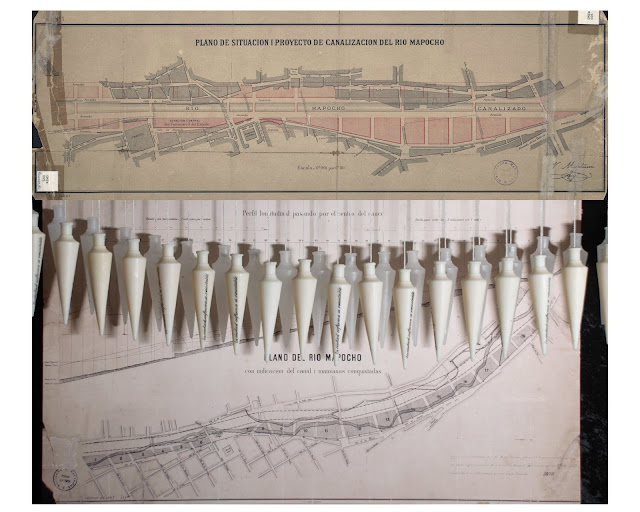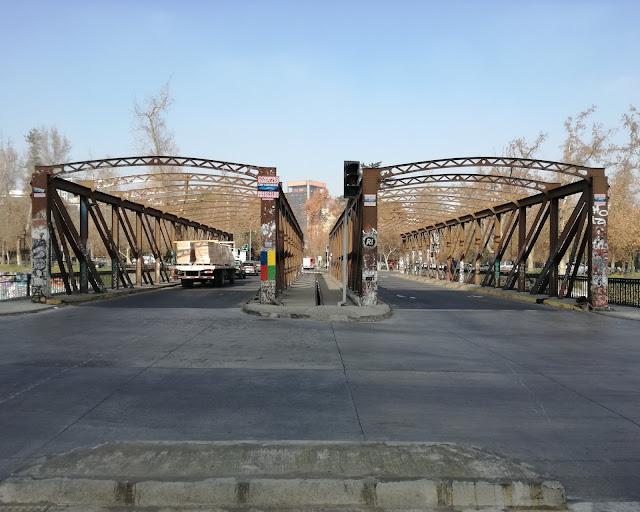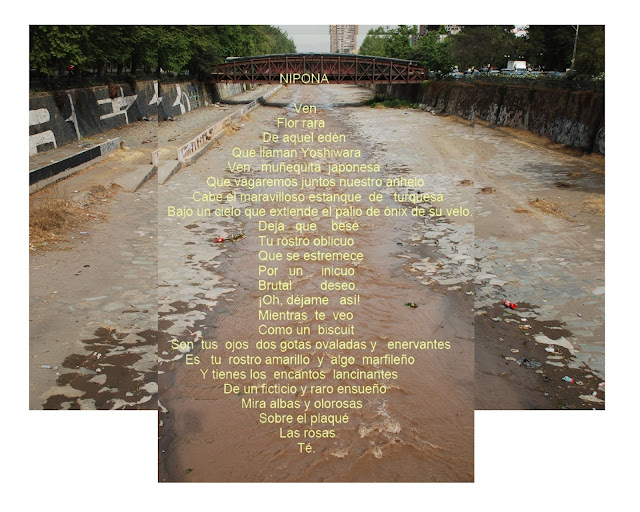Crossways. The Bridge as a Readymade.
“The bridge is a work of art and symbol;
it is a pragmatic and concrete illustration of nature transitioning into
culture”.
Marc Augé, The Symbolism of the Border, 2004.
“Appropriation itself implies time (or times), rhythm (or rhythms), symbols and a practice”.
Henri Lefebvre, the Production of Space. 1991
There are three different designs for the original nine metal bridges, and these were assembled on site, meccano style - an artefact of a modernisation that was easily moved in a post-modern period that Chile never experienced while suspended in a Protected Democracy 1973-1991.
An examples of each of the three, original designs remains today crossing the Mapocho River. These moveable, demountable and re-assembled artefacts are the heritage object of Anywhere within the river’s modernised three-kilometre course.
Marc Augé, The Symbolism of the Border, 2004.
“Here is a thing that I call art, but I
didn’t even make it myself.” As we know, "art," etymologically
speaking, means “to hand make.”
Interview with Marcel Duchamp by George Heard Hamilton about the Readymade. 1959
Interview with Marcel Duchamp by George Heard Hamilton about the Readymade. 1959
“Appropriation itself implies time (or times), rhythm (or rhythms), symbols and a practice”.
Henri Lefebvre, the Production of Space. 1991
Benjamin Vicuña
Mackenna, the writer, historian, presidential candidate, Francophile Mayor and
Father of Santiago’s late 19th Century modernisation, proposed
the canal as a key in making this capital city the “Paris of South America”.
This imagined project of nature as culture was realised a decade after his
death
.
“The idea of
the border is fundamentally ambiguous. It refers to both obstacle (we speak of
natural borders, such as mountains, seas or rivers) and crossway ( natural
passages, such as a hill, or constructed passages such as bridges)”. Marc Augé, 2014
The natural obstacle
and crossways that are the subject of this research are the Mapocho river as
domesticated nature and its canalized urban torrent traversed by its heritage
listed bridges.
Each of these 9
original, 19thC crossings, spread over 3 kilometres of canalized Mapocho river,
extended the historic city grid and replaced a majestic crossway and several precarious traversals. These new crossways linked the historical city with the
northern side of the river that, for Mackenna and his engineer Ansart in 1875,
was the city's south. The causeway of the torrent, when it once flooded, spanned 300
metres and was traversed by a single piece of 18thC engineering and
architecture. Close to this bridges hundredth birthday, its construction of
bricks and mortar, along with its feeble cousin crossways, was destroyed, some
say deliberately, by the energy of the flooding torrent focused by, and during,
the construction of the canal.
To cross the newly contained fluid nature of the Mapocho, nine Meccano bridges formed part of the final design by Engineer Martinez’s 1888. Today, only four of these assemblages remain. Three of these bridges had replaced the directionality of pre-canal bridges but not necessarily their location or span of the now tamed torrent: its width reduced to one third and its centre moved.
Of the four remaining metal bridges of the canalisation project, two are in their original location and the entire quartet was heritage listed shortly after their hundredth birthday and Chile’s transition back to democracy 1988-1991.
To cross the newly contained fluid nature of the Mapocho, nine Meccano bridges formed part of the final design by Engineer Martinez’s 1888. Today, only four of these assemblages remain. Three of these bridges had replaced the directionality of pre-canal bridges but not necessarily their location or span of the now tamed torrent: its width reduced to one third and its centre moved.
Of the four remaining metal bridges of the canalisation project, two are in their original location and the entire quartet was heritage listed shortly after their hundredth birthday and Chile’s transition back to democracy 1988-1991.
There are three different designs for the original nine metal bridges, and these were assembled on site, meccano style - an artefact of a modernisation that was easily moved in a post-modern period that Chile never experienced while suspended in a Protected Democracy 1973-1991.
An examples of each of the three, original designs remains today crossing the Mapocho River. These moveable, demountable and re-assembled artefacts are the heritage object of Anywhere within the river’s modernised three-kilometre course.
In 2020, and from east to west, the site of origin for the first remaining bridge is situated in Plaza Baquedano, the epicentre of
the current social crisis. The bridge itself was re-located some 300 metres downstream in 1986 and is now impassible, a show, literally of popular culture, in the form of a youth theatre, a stage, like the
combative urban theatrics of the demonstrations in Plaza Baquedano. This site of the canal's original bridge, now has a
new/old bridge that has been partially demolished purposefully by the violence of the demonstrations with its railings used in barricades, its paving smashed up for missiles, it's lights smashed for simply what they represent.
The physical bridge itself is turned into a parody of a first-aid centre for those participating
in the violence of the nightly attacks against the police in the plaza and dispersed with teargas and watercannon.
Similarly, the second
and third of the remaining bridges sit in a post-modern schizophrenia of
identical form yet separate origin. Of the two identical bridges, one has been moved next to the other. The two are daily the site of protester road
blocks, with coercive measure for drivers of cars to be permitted to pass, and this has been the
site of arson attacks by demonstrators on public transport buses.
Lastly, Puente los
Carros, AKA 21 de Mayo, sits further downstream as a museum piece of natural disaster (closed due to structural damage of the 8.8 earthquake in 2010)
and now, in a time of equivalent human-made disaster (post 18 October). Of each
of the remaining, four original bridges, this bridge is the only one unmistakably in its original site. Through its site and form, it metaphorically brigdes the historic moment of pre and post modernisation that coincides with the pre
and post Pacific War of (1879 - 1884) that defined Chile territorially as a modern Nation State.
Each of these bridges' form and use (or uselessness) serves as the starting point for this investigation of the bridge as communication in Chilean society.
Methods of Research
Each of these bridges' form and use (or uselessness) serves as the starting point for this investigation of the bridge as communication in Chilean society.
Methods of Research
Practice
lead research based in the uses of public space and temporality. This has a
specific context post 18 October, 2019 in Santiago de Chile.
1.
Henri
Lefebvre’s Spatial Triad . Representations of Space – research,
registration and creation of maps, plans, photographs, scaled models and
collage. Spaces of representation –
research and use of elements of the modern (early and high) city, of old order
of new social/spatial connections and separations. Spatial
practice – research and practice the uses, associations and the possibility
of appropriation and re-appropriation, with images, words, products and the
syntactical writing of space through, and as, pedestrian movement.
2.
James
Meyers’ site specificity. Create site specific works – both of the functional site and the literal
site – social networks, institutions and systems of urban and social
infrastructure and physical locations both proximal and distal.
3.
Ignacio
Solas-Morales’ Terrain Vague –
the use of media for interventions that preserve and are complicit in the
current condition, state of abandonment, decay, vandalism, and/or danger.



Comments
Post a Comment